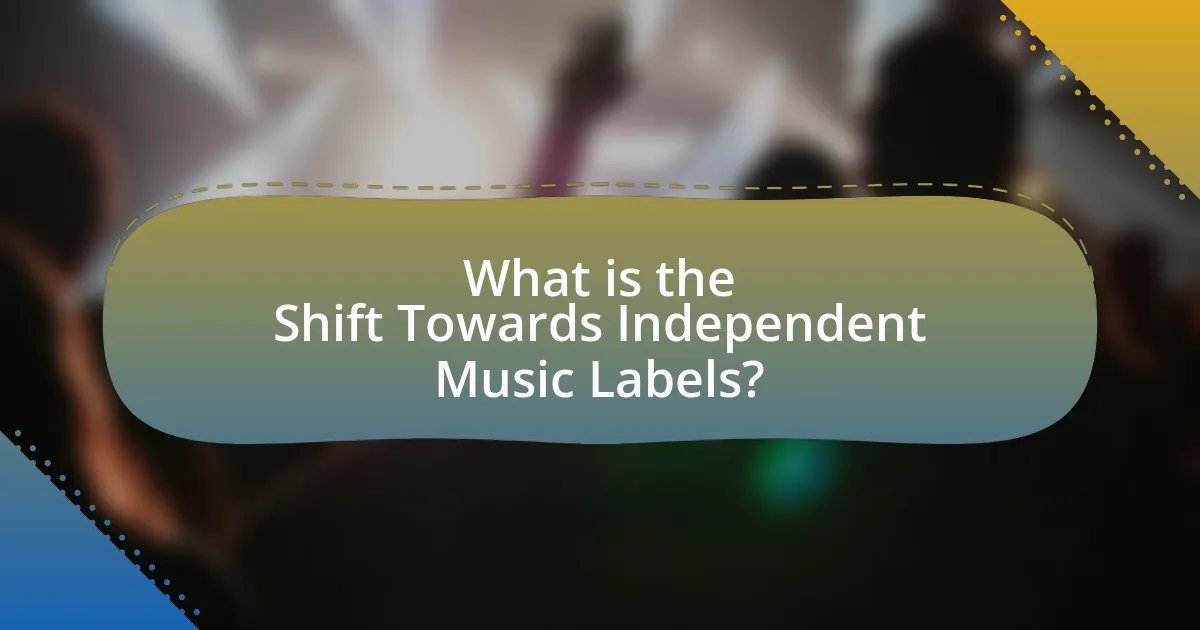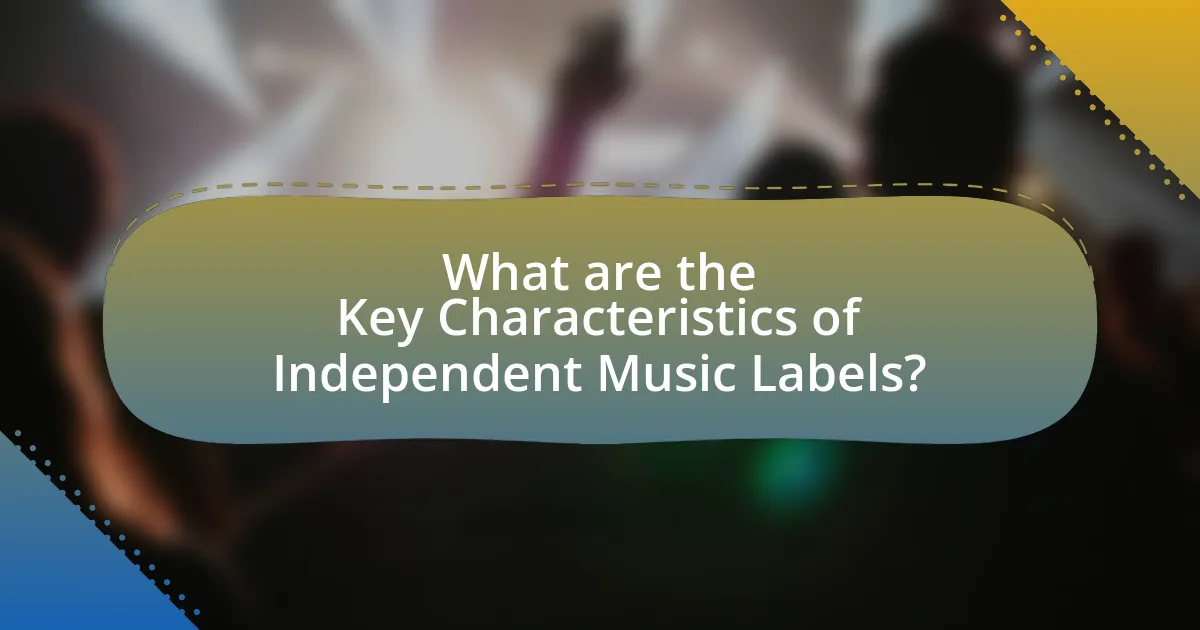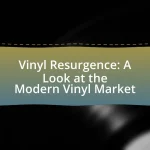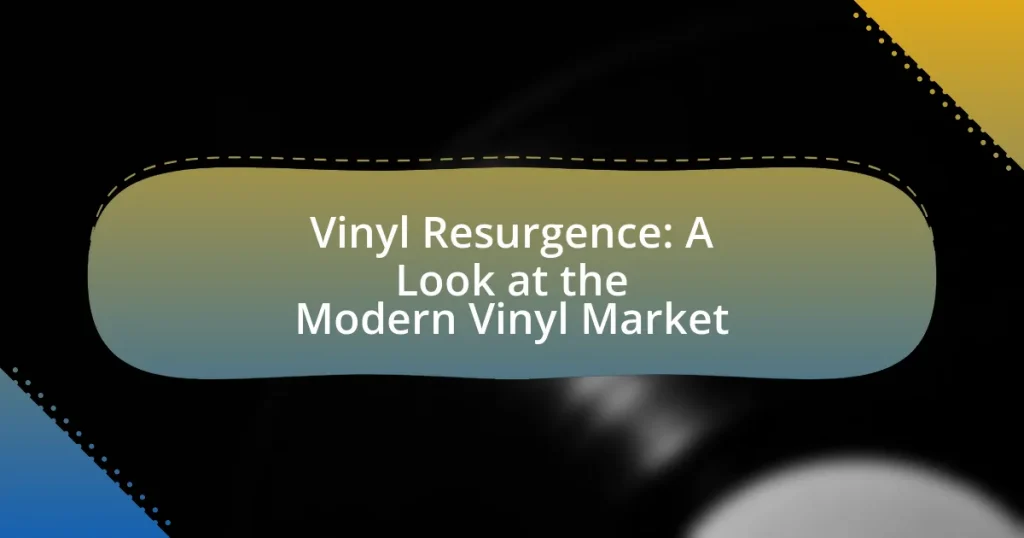The article explores the significant shift towards independent music labels, highlighting their increasing prominence in the music industry as artists seek greater creative control and financial benefits. Independent labels accounted for 40% of global recorded music revenue in 2021, driven by advancements in technology and changing consumer preferences. The article examines the operational differences between independent and major labels, the advantages and challenges faced by independent labels, and the impact of niche marketing on artist success. Additionally, it provides insights into how artists can navigate the independent music landscape effectively, including strategies for building a loyal fanbase and monetizing their music.

What is the Shift Towards Independent Music Labels?
The shift towards independent music labels refers to the increasing trend of artists and musicians opting to release their music through smaller, self-managed labels rather than traditional major record labels. This movement has gained momentum due to advancements in technology, which have made music production and distribution more accessible, allowing artists to retain greater control over their creative output and financial earnings. According to a 2021 report by MIDiA Research, independent labels accounted for 40% of global recorded music revenue, highlighting their growing significance in the industry. This shift is further supported by the rise of digital platforms that facilitate direct artist-to-fan engagement, enabling musicians to build dedicated followings without the need for major label backing.
How has the music industry landscape changed in recent years?
The music industry landscape has shifted significantly towards independent music labels in recent years. This change is evidenced by the rise of digital distribution platforms, which have enabled independent artists to reach global audiences without the need for major label backing. According to a 2021 report by the International Federation of the Phonographic Industry (IFPI), independent labels accounted for 40% of global recorded music revenue, highlighting their growing influence. Additionally, social media and streaming services have empowered artists to promote their work directly to fans, further diminishing the traditional gatekeeping role of major labels.
What factors have contributed to the rise of independent music labels?
The rise of independent music labels has been primarily driven by advancements in technology, changes in consumer behavior, and the desire for artistic freedom. Technological advancements, particularly the internet and digital distribution platforms, have enabled artists to produce and distribute music without the need for major label support, allowing for greater accessibility and lower costs. Additionally, consumers increasingly prefer to support independent artists, leading to a growing market for niche genres and unique sounds. This shift is further fueled by artists seeking creative control over their work, as independent labels often provide more flexibility compared to traditional record companies. According to a report by the International Federation of the Phonographic Industry (IFPI), independent labels accounted for 40% of global recorded music revenues in 2021, highlighting their significant impact on the music industry.
How do independent labels differ from major labels?
Independent labels differ from major labels primarily in their operational scale and approach to artist management. Independent labels typically have smaller budgets, allowing for more creative freedom and personalized attention to artists, while major labels often have extensive resources and marketing power but may impose stricter commercial expectations. For instance, independent labels can focus on niche markets and experimental music, whereas major labels tend to prioritize mainstream appeal and profitability. This distinction is evident in the rise of independent artists who have successfully built careers outside the traditional major label system, reflecting a shift in the music industry landscape.
Why are artists choosing independent labels over major labels?
Artists are choosing independent labels over major labels primarily for greater creative control and higher revenue shares. Independent labels typically offer artists more freedom to express their artistic vision without the constraints often imposed by major labels, which can dictate the direction of music production and marketing. Additionally, independent labels usually provide more favorable financial arrangements, allowing artists to retain a larger percentage of their earnings. For instance, a study by the Future of Music Coalition found that independent artists can earn up to 70% of their revenue compared to the 10-20% often seen with major label contracts. This shift reflects a growing trend where artists prioritize autonomy and financial sustainability in their careers.
What advantages do independent labels offer to artists?
Independent labels offer artists greater creative control and a more personalized approach to their music careers. This autonomy allows artists to make decisions about their sound, branding, and marketing strategies without the constraints often imposed by major labels. Additionally, independent labels typically provide a more equitable revenue-sharing model, enabling artists to retain a larger percentage of their earnings. According to a 2021 report by the Music Industry Research Association, independent artists earned 60% more from their music compared to those signed to major labels, highlighting the financial benefits of working with independent labels.
How does creative control impact an artist’s decision?
Creative control significantly impacts an artist’s decision by allowing them to shape their artistic vision without external constraints. When artists retain creative control, they can make choices that align with their personal style and message, leading to more authentic and innovative work. For instance, a study by the University of Southern California found that artists who maintain creative autonomy are more likely to produce music that resonates with their audience, as they are not pressured to conform to commercial trends. This autonomy often results in a stronger connection between the artist and their fanbase, ultimately influencing their career trajectory and success in the independent music landscape.
What challenges do independent music labels face?
Independent music labels face significant challenges, including limited financial resources, difficulty in marketing and distribution, and competition from major labels. Financial constraints often hinder their ability to invest in artist development and promotional activities, which are crucial for success in a competitive industry. Additionally, independent labels struggle with establishing effective distribution channels, as they may lack the relationships and infrastructure that major labels possess. This results in reduced visibility for their artists. Furthermore, competition from major labels, which have more substantial budgets and marketing power, makes it challenging for independent labels to gain market share and attract audiences. According to a report by the International Federation of the Phonographic Industry, independent labels accounted for only 30% of global recorded music revenues in 2020, highlighting the uphill battle they face in a landscape dominated by larger entities.
How do financial constraints affect independent labels?
Financial constraints significantly limit the operational capabilities of independent labels. These limitations often result in reduced marketing budgets, which hinders their ability to promote artists effectively and reach wider audiences. For instance, a study by the Music Industry Research Association found that independent labels typically allocate only 10-15% of their revenue to marketing, compared to major labels that can invest upwards of 30%. Consequently, independent labels struggle to compete in a market dominated by larger entities with more substantial financial resources, impacting their growth and sustainability.
What marketing challenges do independent labels encounter?
Independent labels encounter significant marketing challenges, primarily due to limited budgets and resources compared to major labels. This financial constraint restricts their ability to invest in extensive promotional campaigns, leading to reduced visibility in a competitive market. Additionally, independent labels often struggle with building brand recognition and audience engagement, as they lack the established networks and marketing expertise that larger labels possess. According to a 2021 report by MIDiA Research, independent labels accounted for 32% of global recorded music revenue, highlighting their growing presence but also underscoring the need for effective marketing strategies to compete with major players.

What are the Key Characteristics of Independent Music Labels?
Independent music labels are characterized by their autonomy from major record companies, allowing for greater creative control and flexibility in artist development. These labels typically prioritize niche markets and unique musical styles, often fostering a close relationship with their artists, which can lead to more personalized marketing and promotion strategies. Additionally, independent music labels often operate with lower budgets, relying on innovative approaches to distribution and promotion, such as digital platforms and social media, to reach audiences effectively. This model has been supported by the rise of streaming services, which has enabled independent labels to thrive despite the dominance of major labels in the industry.
How do independent labels operate differently from major labels?
Independent labels operate with greater creative freedom and flexibility compared to major labels, which often impose strict commercial guidelines. Independent labels typically prioritize artistic expression and niche markets, allowing artists to maintain more control over their music and branding. In contrast, major labels focus on mass-market appeal and profitability, often leading to a more formulaic approach to music production. For example, independent labels can quickly adapt to trends and experiment with diverse genres, while major labels may require extensive approval processes that slow down innovation. This operational difference is evident in the rise of successful independent artists who have built substantial followings without major label backing, demonstrating the effectiveness of this model in today’s music industry.
What is the typical structure of an independent music label?
The typical structure of an independent music label consists of several key roles including the label owner, A&R (Artists and Repertoire) representatives, marketing and promotion staff, and distribution managers. The label owner oversees the overall operations and strategic direction, while A&R representatives scout and sign new talent, ensuring the label’s roster remains competitive. Marketing and promotion staff are responsible for creating campaigns to promote artists and their releases, utilizing both traditional and digital platforms. Distribution managers handle the logistics of getting music to retailers and streaming services, ensuring that the label’s products reach the audience effectively. This structure allows independent labels to operate flexibly and adapt to the rapidly changing music industry landscape.
How do independent labels approach artist development?
Independent labels approach artist development by prioritizing personalized support and long-term growth over immediate commercial success. They often invest time in understanding the artist’s vision, providing tailored resources such as marketing, production, and creative guidance. This approach is evident in the fact that independent labels typically have smaller rosters, allowing for more focused attention on each artist’s unique needs and artistic direction. For instance, according to a 2021 report by the Independent Music Companies Association, independent labels accounted for 39.5% of global recorded music revenue, demonstrating their significant role in nurturing diverse talent and fostering sustainable careers.
What genres are most commonly associated with independent labels?
Independent labels are most commonly associated with genres such as indie rock, folk, punk, and electronic music. These genres thrive in the independent music scene due to their emphasis on artistic freedom and innovation, which are often prioritized by independent labels over commercial considerations. For instance, indie rock has seen significant growth in popularity through independent labels like Sub Pop and Domino, which have launched successful careers for artists such as Nirvana and Arctic Monkeys. Additionally, the folk genre has been represented by independent labels like Anti- and Jagjaguwar, showcasing artists like Bon Iver and Sufjan Stevens. The punk genre has roots in independent labels, with iconic labels like Epitaph and Fat Wreck Chords promoting bands like Bad Religion and NOFX. Electronic music also finds a stronghold in the independent sector, with labels like Warp and Ninja Tune supporting innovative artists like Aphex Twin and Bonobo.
How does genre influence the success of independent labels?
Genre significantly influences the success of independent labels by determining their target audience and marketing strategies. For instance, genres like hip-hop and electronic music have seen substantial growth in independent label success due to their strong online communities and streaming platforms, which facilitate direct artist-to-fan engagement. According to a 2021 report by the International Federation of the Phonographic Industry, independent labels accounted for 40% of global recorded music revenue, with genres such as rock and pop also contributing significantly. This data illustrates that the genre not only shapes the label’s identity but also affects its commercial viability and ability to attract investment and partnerships.
What role does niche marketing play in independent music?
Niche marketing plays a crucial role in independent music by allowing artists to target specific audiences effectively. This targeted approach enables independent musicians to build dedicated fan bases, as they can tailor their marketing strategies to resonate with particular demographics or musical preferences. For instance, independent artists often utilize social media platforms and streaming services to reach niche markets, which can lead to higher engagement rates compared to mainstream marketing efforts. According to a 2021 report by MIDiA Research, independent music accounted for 43% of global music revenue, highlighting the effectiveness of niche marketing in driving sales and audience growth within this sector.
What impact do independent labels have on the music industry?
Independent labels significantly influence the music industry by fostering diversity and innovation. They provide platforms for emerging artists who may not fit the mainstream mold, allowing for a broader range of musical styles and voices. According to a 2021 report by the International Federation of the Phonographic Industry, independent labels accounted for 40% of global recorded music revenue, highlighting their economic impact. Furthermore, independent labels often prioritize artist development and creative control, which can lead to unique sounds and artistic expressions that challenge conventional industry standards. This shift towards independent music labels has reshaped market dynamics, encouraging major labels to adapt and diversify their offerings.
How do independent labels contribute to diversity in music?
Independent labels contribute to diversity in music by promoting a wide range of genres and underrepresented artists. These labels often prioritize artistic freedom over commercial viability, allowing for innovative sounds and diverse cultural expressions. For instance, according to a 2020 report by the Music Industry Research Association, independent labels accounted for 35% of global music sales, showcasing their significant role in the market. This market share enables them to support niche genres and marginalized voices that major labels may overlook, thereby enriching the overall music landscape.
What trends have emerged from the success of independent labels?
The success of independent labels has led to several key trends in the music industry. Firstly, there is a notable increase in artist autonomy, allowing musicians to maintain creative control over their work and branding. This shift is evidenced by the rise of platforms like Bandcamp and SoundCloud, which empower artists to distribute their music directly to fans without the need for major label intervention. Additionally, independent labels are increasingly focusing on niche markets, catering to specific genres and communities, which has resulted in a more diverse music landscape. According to a 2022 report by MIDiA Research, independent labels accounted for 40% of global recorded music revenue, highlighting their growing influence and the shift in consumer preferences towards unique and authentic music experiences. Furthermore, the use of social media for marketing and fan engagement has become a standard practice among independent artists, enabling them to build dedicated followings and promote their music effectively.

How Can Artists Successfully Navigate the Independent Music Landscape?
Artists can successfully navigate the independent music landscape by leveraging digital platforms for distribution, engaging directly with their audience, and utilizing social media for promotion. Digital platforms like Spotify and Bandcamp allow artists to distribute their music globally without the need for traditional record labels, which can limit creative control and revenue. Engaging directly with audiences through live performances, virtual events, and fan interactions fosters a loyal fanbase, essential for independent success. Additionally, social media platforms enable artists to promote their work, share their stories, and connect with fans, which is crucial in building a brand and increasing visibility. According to a 2021 report by the International Federation of the Phonographic Industry, independent labels accounted for 40% of global recorded music revenue, highlighting the viability of this approach.
What strategies should artists consider when choosing an independent label?
Artists should consider the label’s reputation, distribution capabilities, and alignment with their artistic vision when choosing an independent label. A label’s reputation can significantly impact an artist’s credibility and marketability; for instance, labels with a history of successful artist development often attract more attention from media and audiences. Distribution capabilities are crucial as they determine how effectively an artist’s music reaches listeners; independent labels with established networks can enhance an artist’s visibility. Lastly, alignment with an artist’s artistic vision ensures that the label supports their creative direction, which is essential for long-term satisfaction and success. These strategies help artists make informed decisions that can lead to fruitful partnerships in the independent music landscape.
How can artists assess the reputation of an independent label?
Artists can assess the reputation of an independent label by researching its history, artist roster, and industry connections. Evaluating the label’s track record with previous artists, including their success in terms of album sales and chart performance, provides insight into its effectiveness. Additionally, artists should examine online reviews and testimonials from current and former label signees, as these can reveal the label’s reliability and support for its artists. Engaging with industry professionals and attending music events can also help artists gather firsthand information about the label’s standing within the music community.
What questions should artists ask before signing with a label?
Artists should ask about the label’s distribution capabilities before signing, as effective distribution is crucial for reaching audiences. Understanding how the label plans to promote the artist’s music, including marketing strategies and budget allocation, is essential for ensuring visibility in a competitive market. Additionally, artists should inquire about the terms of the contract, including the length, rights to their music, and any potential royalties, to avoid unfavorable conditions. It’s also important to ask about the label’s track record with similar artists, as this can provide insight into the label’s effectiveness and commitment to artist development. Lastly, artists should clarify the level of creative control they will retain, as maintaining artistic integrity is vital for long-term success.
What resources are available for artists in the independent music scene?
Artists in the independent music scene have access to various resources, including digital distribution platforms, social media marketing tools, and funding opportunities. Digital distribution platforms like DistroKid and TuneCore allow artists to release their music on major streaming services, ensuring wider reach and accessibility. Social media marketing tools, such as Hootsuite and Buffer, help artists promote their work and engage with fans effectively. Additionally, crowdfunding platforms like Kickstarter and Patreon provide financial support, enabling artists to fund their projects directly through fan contributions. These resources collectively empower independent artists to navigate the music industry more effectively and sustain their careers.
How can artists leverage social media for promotion?
Artists can leverage social media for promotion by creating engaging content that showcases their music and personality, thereby building a direct connection with their audience. Platforms like Instagram, TikTok, and Twitter allow artists to share snippets of their work, behind-the-scenes footage, and personal stories, which can enhance fan engagement and loyalty. According to a 2021 report by the International Federation of the Phonographic Industry, 75% of music consumers discover new music through social media platforms, highlighting the effectiveness of these channels for reaching potential listeners. Additionally, artists can utilize targeted advertising on these platforms to reach specific demographics, further increasing their visibility and potential fan base.
What role do music festivals play in supporting independent artists?
Music festivals play a crucial role in supporting independent artists by providing them with a platform to showcase their music to larger audiences. These events often feature a diverse lineup that includes emerging talent, allowing independent musicians to gain exposure and connect with fans. For instance, festivals like South by Southwest (SXSW) and Coachella have been known to launch the careers of numerous independent artists by offering them performance slots alongside established acts. Additionally, music festivals often facilitate networking opportunities with industry professionals, which can lead to collaborations, bookings, and increased visibility in the music scene. This support is vital, as independent artists typically lack the marketing resources that major labels provide, making festivals an essential avenue for their growth and success.
What best practices should artists follow in the independent music industry?
Artists in the independent music industry should prioritize building a strong online presence through social media and streaming platforms. This approach allows artists to engage directly with their audience, promote their music, and gain visibility without relying on traditional record labels. According to a 2021 report by the International Federation of the Phonographic Industry, independent artists who actively use social media platforms see a 30% increase in fan engagement compared to those who do not. Additionally, artists should focus on creating high-quality content, including professional recordings and visually appealing music videos, as these elements significantly enhance their marketability. Research from the Music Industry Research Association indicates that well-produced music and visuals can lead to a 50% higher likelihood of playlist placements on major streaming services. Networking with other artists and industry professionals is also crucial, as collaborations can expand reach and introduce artists to new audiences.
How can artists build a loyal fanbase without major label support?
Artists can build a loyal fanbase without major label support by leveraging social media platforms to engage directly with their audience. By consistently sharing authentic content, artists can create a personal connection with fans, which fosters loyalty. For instance, independent artists like Chance the Rapper have successfully utilized platforms like Instagram and Twitter to communicate with their followers, share behind-the-scenes content, and promote their music, resulting in a dedicated fanbase. Additionally, hosting live performances, whether virtual or in-person, allows artists to interact with fans in real-time, further solidifying their relationship. Statistics show that 70% of fans feel more connected to artists who engage with them on social media, highlighting the effectiveness of this approach in building a loyal following.
What are effective ways to monetize music independently?
Effective ways to monetize music independently include selling music directly to fans, utilizing streaming platforms, offering merchandise, and leveraging crowdfunding. Selling music directly through platforms like Bandcamp allows artists to retain a larger percentage of sales compared to traditional distribution methods. Streaming platforms such as Spotify and Apple Music provide exposure and generate revenue through royalties, although the payout per stream is low. Merchandise sales, including apparel and physical copies of music, can significantly boost income, with artists often earning higher margins. Crowdfunding through sites like Patreon enables fans to support artists directly, providing a steady income stream in exchange for exclusive content or experiences. According to a 2021 report by the International Federation of the Phonographic Industry, independent artists are increasingly leveraging these methods to achieve financial sustainability in the evolving music landscape.














